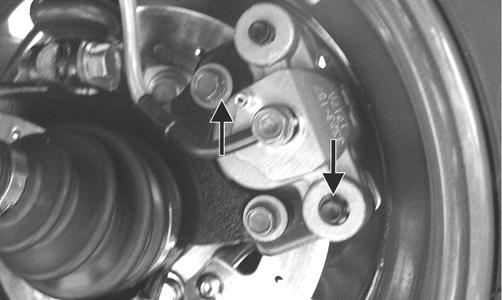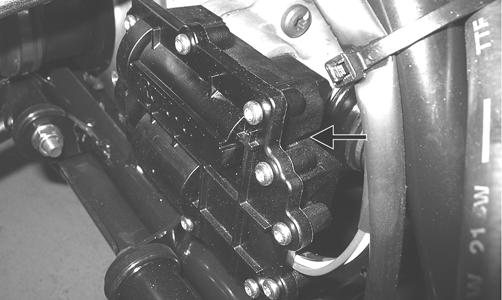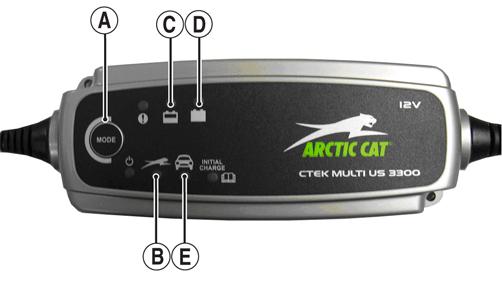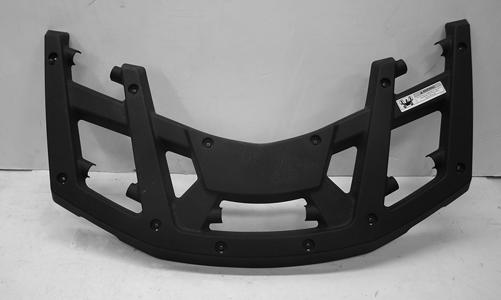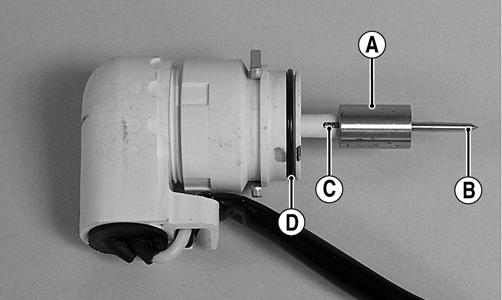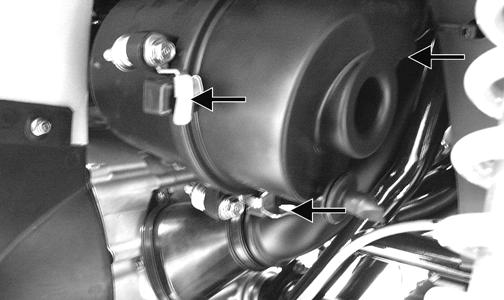
11 minute read
General Information/Foreword
This Arctic Cat Service Manual contains service, maintenance, and troubleshooting information for the 2016 Arctic Cat Alterra 400 ATV model and is designed to aid in service-oriented applications. This manual is divided into sections. Each section covers a specific ATV component or system and, in addition to the standard service procedures, includes disassembling, inspecting, and assembling instructions. When using this manual as a guide, the technician should use discretion as to how much disassembly is needed to address any given condition.
This service manual is designed primarily for use by an Arctic Cat CatMaster Basic Level technician. The procedures found in this manual are of varying difficulty, and certain service procedures in this manual require one or more special tools to be completed. The technician should use sound judgment when determining which procedures can be completed based on their skill level and access to appropriate special tools. NOTE: Whenever a part is worn excessively,
cracked, or damaged in any way, replacement is necessary.
When replacement of parts is necessary, use only genuine Arctic Cat ATV parts. They are precision-made to ensure high quality and correct fit. Refer to the Illustrated Parts Manual for the correct part number, quantity, and description. Arctic Cat ATV publications and decals display the words Warning, Caution, Note, and At This Point to emphasize important information. The symbol ! WARNING identifies personal safety-related information. Be sure to follow the directive because it deals with the possibility of serious injury or even death. A CAUTION identifies unsafe practices which may result in ATV-related damage. Follow the directive because it deals with the possibility of damaging part or parts of the ATV. The symbol NOTE: identifies supplementary information worthy of particular attention. The symbol AT THIS POINT directs the technician to certain and specific procedures to promote efficiency and to improve clarity. At the time of publication, all information, photographs, and illustrations were technically correct. Some photographs used in this manual are used for clarity purposes only and are not designed to depict actual conditions. Because Arctic Cat Inc. constantly refines and improves its products, no retroactive obligation is incurred. All materials and specifications are subject to change without notice.
Product Service and Warranty Department Arctic Cat Inc.
Specifications
NOTE: Specifications subject to change without notice.
CHASSIS
Tire Size Front - 24 x 8-12 Rear - 24 x 10-12 Tire Inflation Pressure 27.6 kPa (4 psi)
MISCELLANY
Spark Plug Type NGK CPR8E Spark Plug Gap 0.7-0.8 mm (0.028-0.031 in.) Gas Tank Capacity (rated) 15.1 L (4.0 U.S. gal.) Rear Drive Capacity 250 ml (8.5 fl oz)* Front Differential Capacity 275 ml (9.3 fl oz)** Engine Oil Capacity 3.3 L (3.5 U.S. qt) - Overhaul 2.8 L (3.0 U.S. qt) - Change Gasoline (recommended) 87 Octane Regular Unleaded Engine Oil (recommended) Arctic Cat ACX All Weather (Synthetic) Differential/Rear Drive Lubricant SAE Approved 80W-90 Hypoid Drive Belt Width 28.5 mm (1.12 in.) Brake Fluid DOT 4 Taillight/Brakelight 12V/5W/21W Headlight 12V/35W (4)
FUEL SYSTEM
Carburetor Type Keihin CVK34 Main Jet 112 Slow Jet 38 Pilot Screw Setting (turns) 2 1/2 Jet Needle NLGB Idle RPM (engine warm) 1250-1350 Starter Jet 75 Float Height 17 mm Throttle Cable Free-Play (at lever) 3-6 mm (1/8-1/4 in.)
ELECTRICAL SYSTEM
Ignition Timing 10° BTDC @ 1500 RPM Spark Plug Cap 4000-6000 ohms Ignition Coil Resistance (primary) Less than 1 ohm (secondary) N.A. Ignition Coil Peak Voltage (primary/CDI) 250-375 DC volts Stator Coil Resistance (trigger) 90-110 ohms (charging) Less than 1 ohm Peak Voltage (trigger) 7.8-9.3 volts AC Generator Output (no load) 60 AC volts @ 3000 RPM Generator Output (approx) 220W @ 5000 RPM
CYLINDER, PISTON, AND RINGS
Piston Skirt/Cylinder Clearance 0.060-0.073 mm Piston Diameter 15 mm from Skirt End 80.98-81.00 mm Piston Ring Free End Gap (max) (1st) 11.6 mm (2nd) 10.1 mm Bore x Stroke 81.0 x 71.2 mm Cylinder Trueness (max) 0.01 mm Piston Ring End Gap - Installed (min) 0.15 mm Piston Ring to Groove Clearance (max)(1st/2nd) 0.06 mm Piston Ring Groove Width (1st) 1.01-1.03 mm (2nd) 1.21-1.23 mm (oil) 2.01-2.03 mm Piston Ring Thickness (1st) 0.97-.99 mm (2nd) 1.17-1.19 mm Piston Pin Bore (max) 20.008 mm Piston Pin (min) 19.994 mm
* One inch below plug threads. ** At the plug threads.
Connecting Rod (small end) (max) 20.021 mm Connecting Rod (big end side-to-side)(max) 0.7 mm Connecting Rod (big end width) 21.95-22.00 mm Connecting Rod (small end deflection)(max) 3.0 mm Crankshaft (web-to-web) 60.9 mm Crankshaft Runout (max) 0.03 mm
VALVES AND GUIDES
Valve Face Diameter (intake) (exhaust) 30.6 mm 27.9 mm
Valve/Tappet Clearance (intake) (cold engine) (exhaust)
0.10 mm 0.23 mm Valve Guide/Stem (intake) 0.10 mm Clearance (max) (exhaust) 0.30 mm Valve Guide Inside Diameter 5.000-5.012 mm Valve Head Thickness (min) 2.30 mm Valve Seat Angle (intake/exhaust) 45° Valve Spring Free Length (min) 40.4 mm Valve Spring Tension @ 31.1 mm 21.4 kg (47.18 lb)
CAMSHAFT AND CYLINDER HEAD
Cam Lobe Height (min) (intake/exhaust) 33.53 mm Camshaft Journal Oil Clearance (max) 0.040 mm Camshaft Journal Holder (right & center) 21.98-22.04 mm Inside Diameter (left) 17.48-17.53 mm Camshaft Journal Outside (right & center) 21.97-21.98 mm Diameter (left) 17.47-17.48 mm Camshaft Runout (max) 0.03 mm Cylinder Head/Cover Distortion (max) 0.05 mm
Torque Specifications
Part EXHAUST COMPONENTS
Part Bolted To Torque ft-lb N-m
Exhaust Pipe Engine 20 27 Spark Arrester Muffler 48 in.-lb 5.5 ELECTRICAL COMPONENTS
Coil Frame 12 16 Starter Motor Positive Cable Starter Motor 8 11 CHASSIS COMPONENTS
Footrest Frame (8 mm) 20 27 Bumper Frame (8 mm) 20 27 STEERING COMPONENTS
Steering Post Bearing Housing Frame 20 27 Handlebar Cap Steering Post 20 27 Lower Steering Post Bearing Cap Steering Post 40 54 Screw Tie Rod End** Steering Post Arm 30 41
ENGINE/TRANSMISSION
Clutch Shoe** Crankshaft 147 199 Clutch Cover/Housing Assembly Crankcase 8 11 Left-Side Cover Crankcase 8 11 Crankcase Half (6 mm) Crankcase Half 10 13.5 Crankcase Half (8 mm) Crankcase Half 21 28
Cylinder Nut Crankcase Half 8 11 Cylinder Head (Cap Screw) Crankcase 28 38 Cylinder Head Nut Cylinder 20 27 Cylinder Head (6 mm) Cylinder 8 11 Cylinder Head (8 mm) Cylinder 20 27 Cylinder Head Cover Cylinder Head 8 11 Oil Pump Drive Gear** Crankshaft 63 86
Part Part Bolted To Torque ft-lb N-m
Driven Pulley Nut** Driveshaft 147 199 Ground Cable Engine 8 11 Output Shaft Flange Nut Output Shaft 74 101 Magneto Rotor Nut Crankshaft 107 146 Cam Sprocket** Camshaft 11 15 Valve Adjuster Jam Nut Valve Adjuster 7 9.5 Starter Motor Crankcase 8 11 Oil Fitting Engine 8 11 Starter One-Way Clutch Flywheel 26 35 Oil Pump* Crankcase 8 11 Movable Drive Face Nut** Clutch Shaft 147 199 Oil Cooler Hose Clamps Engine/Oil Cooler 30 in.-lb 3.4 Valve Inspection Cover Cylinder Head Cover 8 11 SUSPENSION COMPONENTS (Front)
A-Arm Frame 35 47 Knuckle Ball Joint 35 47 Shock Absorber Frame 35 47 Shock Absorber Upper A-Arm 35 47 Knuckle A-Arm 35 47 SUSPENSION COMPONENTS (Rear)
Shock Absorber (Upper) Frame 35 47 Shock Absorber (Lower) Lower A-Arm 35 47 A-Arm Frame 35 47 Knuckle A-Arm 35 47 BRAKE COMPONENTS
Brake Disc* Hub 15 20 Brake Hose Caliper 20 27 Brake Hose Master Cylinder 20 27 Brake Hose Auxiliary Brake Cylinder 20 27 Master Cylinder (Rear) Frame 8 11 Master Cylinder Clamp (Front) Master Cylinder 5.5 8 Hydraulic Caliper**** Knuckle 20 27 Auxiliary Brake Pedal Pivot 20 27 DRIVE TRAIN COMPONENTS
Engine Mounting Through-Bolt Frame 38 52 Front Differential Frame/Differential Bracket 38 52 Output Flange Rear Output Flange Joint 20 27 Input Shaft Housing Differential Housing 18 25 Pinion Housing Gear Case Housing 18 25 Differential Housing Cover*** Differential Housing 18 25 Drive Bevel Gear Nut** Shaft 59 80 Driven Bevel Gear Nut** Driven Shaft 59 80 Thrust Button Gear Case Cover 8 11 Hub Nut Shaft/Axle (max) 200 272 Oil Drain Plug Front Differential/Rear Drive 45 in.-lb 5 Oil Fill Plug Front Differential/Rear Drive 16 22 Oil Drain Plug Engine 20 27 Rear Drive Input Shaft Housing Differential Housing 23 31 Lock Collar Differential Housing 125 169 Wheel (Steel) Hub 40 54 Wheel (Aluminum) Hub 80 108 Rear Drive Gear Case Frame 38 52 Engine Output Flange Rear Gear Case Input 20 27 Flange * w/Blue Loctite #243 ** w/Red Loctite #271 *** w/Green Loctite #609 ****w/“patch-lock”
Torque Conversions (ft-lb/N-m)
Gasoline - Oil - Lubricant
ft-lb N-m ft-lb N-m ft-lb N-m ft-lb N-m 1 1.4 26 35.4 51 69.4 76 103.4 2 2.7 27 36.7 52 70.7 77 104.7 3 4.1 28 38.1 53 72.1 78 106.1 4 5.4 29 39.4 54 73.4 79 107.4 5 6.8 30 40.8 55 74.8 80 108.8 6 8.2 31 42.2 56 76.2 81 110.2 7 9.5 32 43.5 57 77.5 82 111.5 8 10.9 33 44.9 58 78.9 83 112.9 9 12.2 34 46.2 59 80.2 84 114.2 10 13.6 35 47.6 60 81.6 85 115.6 11 15 36 49 61 83 86 117 12 16.3 37 50.3 62 84.3 87 118.3 13 17.7 38 51.7 63 85.7 88 119.7 14 19 39 53 64 87 89 121 15 20.4 40 54.4 65 88.4 90 122.4 16 21.8 41 55.8 66 89.8 91 123.8 17 23.1 42 57.1 67 91.1 92 125.1 18 24.5 43 58.5 68 92.5 93 126.5 19 25.8 44 59.8 69 93.8 94 127.8 20 27.2 45 61.2 70 95.2 95 129.2 21 28.6 46 62.6 71 96.6 96 130.6 22 29.9 47 63.9 72 97.9 97 131.9 23 31.3 48 65.3 73 99.3 98 133.3 24 32.6 49 66.6 74 100.6 99 134.6 25 34 50 68 75 102 100 136
FILLING GAS TANK ! WARNING
Always fill the gas tank in a well-ventilated area. Never add fuel to the ATV gas tank near any open flames or with the engine running. DO NOT SMOKE while filling the gas tank.
Since gasoline expands as its temperature rises, the gas tank must be filled to its rated capacity only. Expansion room must be maintained in the tank particularly if the tank is filled with cold gasoline and then moved to a warm area.
Tighten the gas tank cap securely after filling the tank.
! WARNING
Do not overflow gasoline when filling the gas tank. A fire hazard could materialize. Always allow the engine to cool before filling the gas tank.
! WARNING
Do not over-fill the gas tank.
RECOMMENDED GASOLINE The recommended gasoline to use is 87 minimum octane regular unleaded. In many areas, oxygenates are added to the gasoline. Oxygenated gasolines containing up to 10% ethanol or 5% methane are acceptable gasolines. When using ethanol blended gasoline, it is not necessary to add a gasoline antifreeze since ethanol will prevent the accumulation of moisture in the fuel system.
CAUTION
Do not use white gas. Only Arctic Cat approved gasoline additives should be used.
RECOMMENDED ENGINE/ TRANSMISSION OIL CAUTION
Any oil used in place of the recommended oil could cause serious engine damage. Do not use oils which contain graphite or molybdenum additives. These oils can adversely affect clutch operation. Also, not recommended are racing, vegetable, non-detergent, and castor-based oils.
The recommended oil to use is Arctic Cat ACX All Weather synthetic engine oil, which has been specifically formulated for use in this Arctic Cat engine. Although Arctic Cat ACX All Weather synthetic engine oil is the only oil recommended for use in this engine, use of any API certified SM 0W-40 oil is acceptable.
OILCHARTJ
RECOMMENDED FRONT DIFFERENTIAL/REAR DRIVE LUBRICANT The recommended lubricant is Arctic Cat Gear Lube or an equivalent gear lube which is SAE approved 80W-90 hypoid. This lubricant meets all of the lubrication requirements of the Arctic Cat ATV front differentials and rear drives.
CAUTION
Any lubricant used in place of the recommended lubricant could cause serious front differential/rear drive damage.
Preparation For Storage
CAUTION
Prior to storing the ATV, it must be properly serviced to prevent rusting and component deterioration.
Arctic Cat recommends the following procedure to prepare the ATV for storage. 1.Clean the seat cushion (cover and base) with a damp cloth and allow to dry. 2.Clean the ATV thoroughly by washing dirt, oil, grass, and other foreign matter from the entire ATV.
Allow the ATV to dry thoroughly. DO NOT get water into any part of the engine or air intake. 3.Either drain the gas tank or add a fuel stabilizer to the gas in the gas tank. 4.Clean the interior of the air filter housing. 5.Drain the carburetor float bowl and turn off the fuel valve (located on the right side of the gas tank). 6.Plug the hole in the exhaust system with a clean cloth.
7.Apply light oil to the upper steering post bushing and plungers of the shock absorbers. 8.Tighten all nuts, bolts, cap screws, and screws. Care must be taken that all calibrated nuts, cap screws, and bolts are tightened to specifications. NOTE: For storage, use a battery maintainer or
make sure the battery is fully charged (see Battery section in this manual).
9.Disconnect the battery cables (negative cable first); then remove the battery, clean the battery posts and cables, and store in a clean, dry area. 10.Store the ATV indoors in a level position.
CAUTION
Avoid storing outside in direct sunlight and avoid using a plastic cover as moisture will collect on the ATV causing rusting.
Preparation After Storage
Taking the ATV out of storage and correctly preparing it will assure many miles and hours of trouble-free riding. Arctic Cat recommends the following procedure to prepare the ATV. 1.Clean the ATV thoroughly. 2.Clean the engine. Remove the cloth from the exhaust system. 3.Check all control wires and cables for signs of wear or fraying. Replace if necessary. 4.Change the engine/transmission oil and filter. 5.Charge the battery; then install. Connect the battery cables making sure to connect the positive cable first.
6.Check the entire brake systems (fluid level, pads, etc.), all controls, headlights, taillight, brakelight, and headlight aim; adjust or replace if necessary. 7.Check the tire pressure. Inflate to recommended pressure as necessary. 8.Tighten all nuts, bolts, cap screws, and screws making sure all calibrated nuts, cap screws, and bolts are tightened to specifications. 9.Make sure the steering moves freely and does not bind.
10.Check the spark plug. Clean or replace as necessary. 11.Check the air filter and the air filter housing. Clean or replace as necessary.
CAUTION

